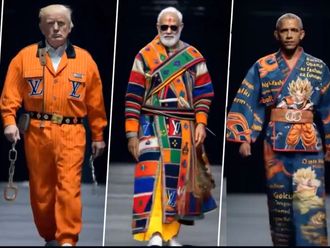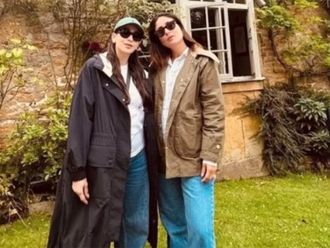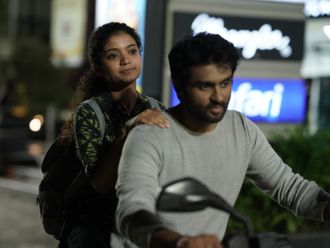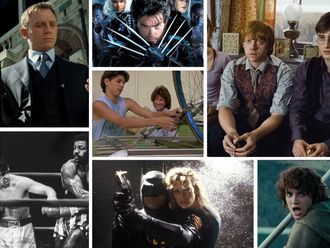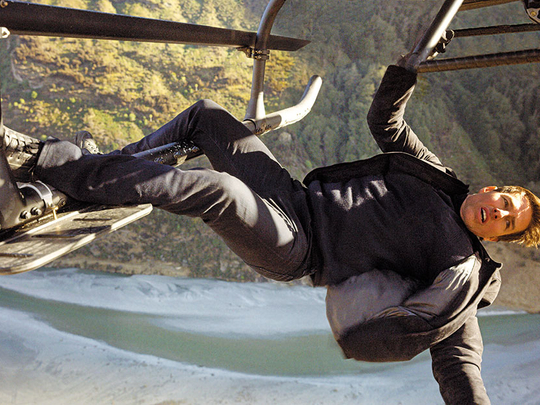
The Mission: Impossible movie franchise has become synonymous with daring stunts where lead actor Tom Cruise climbs the highest building in the world or hangs off the side of a speeding plane.
Mission: Impossible - Fallout, which releases in the UAE on July 26, sees Cruise become the first actor on camera to perform a Halo (high altitude, low opening) skydive from 7,620 metres.
The film’s stunt coordinator, Wade Eastwood, who has also worked on the James Bond and Jack Reacher movies, spoke about how stunts are devised and what drives Cruise, 56, to perform them himself.
Who comes up with the ideas for Mission: Impossible stunts?
We get an outline [for the movie], then I will try and come up with the style, and it’s really Chris [McQuarrie, director], Tom and I who will sit down and hash out a bunch of ideas. The big difference between Mission: Impossible and other movies is that all the action is very character-based. Tom is playing a character who isn’t superhuman.
What kind of training do you put Cruise through?
I lay out a training schedule — this is how much driving we have to do, this many sessions on a bike, and he will adhere to it 100 per cent. And then I will push his training harder and harder. The harder you push, the more the training is gruelling — he will suffer but he will never quit. We employ some of the world’s best to take Tom to the next level. You are trying to teach someone to get as close to that world class level as you can, not in 20 years but in two months.
How much training was there for the Halo stunt?
We built the largest outdoor wind tunnel in the world. In lunch breaks, if Tom had an hour between scenes, we’d just run down to the wind tunnel. I did 500 hours in the wind tunnel working out the moves. We came up with a helmet that didn’t have an ugly oxygen attachment to the nose and mouth and that would work for real. We did 150 jumps in Abu Dhabi and 102 different takes to make it perfect.
What other stunts will audiences see?
There’s a helicopter stunt in New Zealand. It’s the biggest helicopter sequence ever shot — 30 helicopters in the air.
There’s a mountaineering sequence in Norway. That was pretty hairy, hanging off the side of the rock and dropping, freezing snow everywhere. There’s a big car and motorcycle chase in Paris and with a truck and a boat.
Has Cruise ever turned down a stunt because it’s too dangerous?
No. He would have been one of the best stunt men in the world if he wasn’t an actor, for sure. With stunt men and women it doesn’t matter how your face looks. But with Tom, he is also playing a character, so he has to jump out and act the character while trying to be a professional. That’s the challenge that to me stands him above the rest.
How many actors insist on doing so many of their own stunts?
It’s quite rare. There are a few actors who are quite athletic, who do a lot of their own stuff. Hugh Jackman is a mega athlete. Tom is a very physical person. He never approaches it from an egotistical point of view. He approaches it very much as ‘it’s cool for the character and the story and I’ll have a lot of fun training and getting to do this cool stuff.’
What sets the Mission: Impossible franchise apart from other stunt-heavy movies?
The Tom factor. Tom is just an energy ball. He lifts you up, he lifts the crew up, he makes everyone want to make a great movie. You just feed off his energy.
Don’t miss it
Mission: Impossible - Fallout releases in the UAE on July 26.
HOW THE HALO JUMP WAS DONE IN ABU DHABI
Tom Cruise became the first actor to do a Halo jump on camera, says Mission: Impossible – Fallout second unit director and stunt coordinator Wade Eastwood. And the stunt was done right here in the UAE.
A Halo jump, which stands for high altitude, low open, is a military tactic employed when soldiers need to enter a country without being detected.
Before take-off, Cruise spent 20 minutes on the ground breathing pure oxygen in order to avoid decompression sickness. The actor then climbed to 7,620 metres into the air, at which time all the lighting on the aircraft turned from white to red.
“You’re talking about Tom jumping out of a plane that’s travelling at 165 miles an hour [265km/h], falling at 200 miles an hour, and he has to position himself so that he lands exactly three feet away from the camera, with 20,000 feet beneath him,” explained writer-director Christopher McQuarrie.
The scene also had to be filmed during sunset, which meant that the cast and crew only had exactly three minutes to nail the shot.
“The light has to be perfect. We only get one shot a day,” said Eastwood.
One of the largest wind tunnels in the world had to be built in order for Cruise to perfect the stunt. He practiced “over a hundred” times. A special helmet was built for the actor, as both a prop and a “life-saving device”.
Cruise practiced five jumps a day out of a Twin Otter utility aircraft, and three jumps out of a C-17 military transport aircraft.
“We needed the UAE. Had they not stepped in, we would not have been able to accomplish the sequence,” said Cruise, in a new behind-the-scenes clip.
He spent most of March filming in Abu Dhabi.
Abu Dhabi Film Commission posted a photo of Cruise wearing a flight suit in front a plane marked UAE Air Force, with the caption: “Mission made possible with @tomcruise #inAbuDhabi.”
During filming, as Cruise attempted to land near the camera, there was also a risk of mid-air collisions. But the shoot was completed without incident.
“I can’t wait for an audience to see this. I still can’t believe we got it,” said Cruise.
The 55-year-old actor is known for performing his own stunts. In 2010, he scaled the Burj Khalifa in Dubai for Mission: Impossible – Ghost Protocol, the fourth instalment in the franchise.
— Marwa Hamad, Senior Reporter



